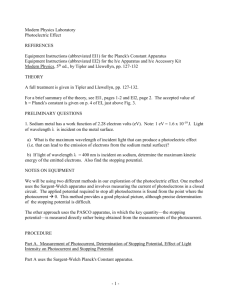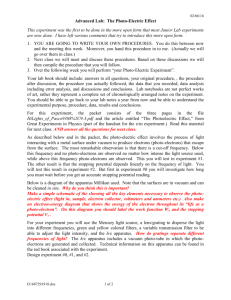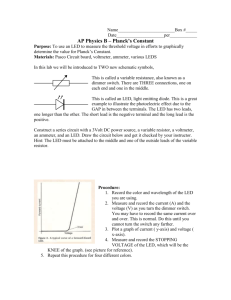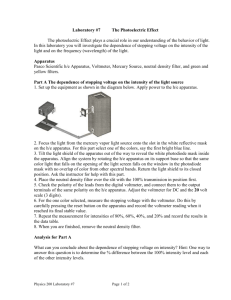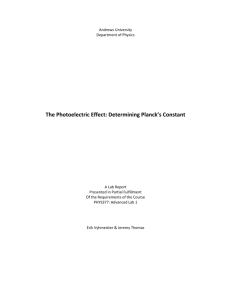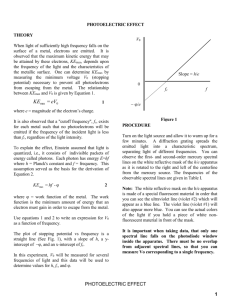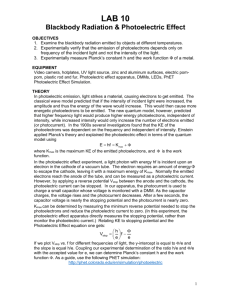Modern Physics Laboratory
advertisement
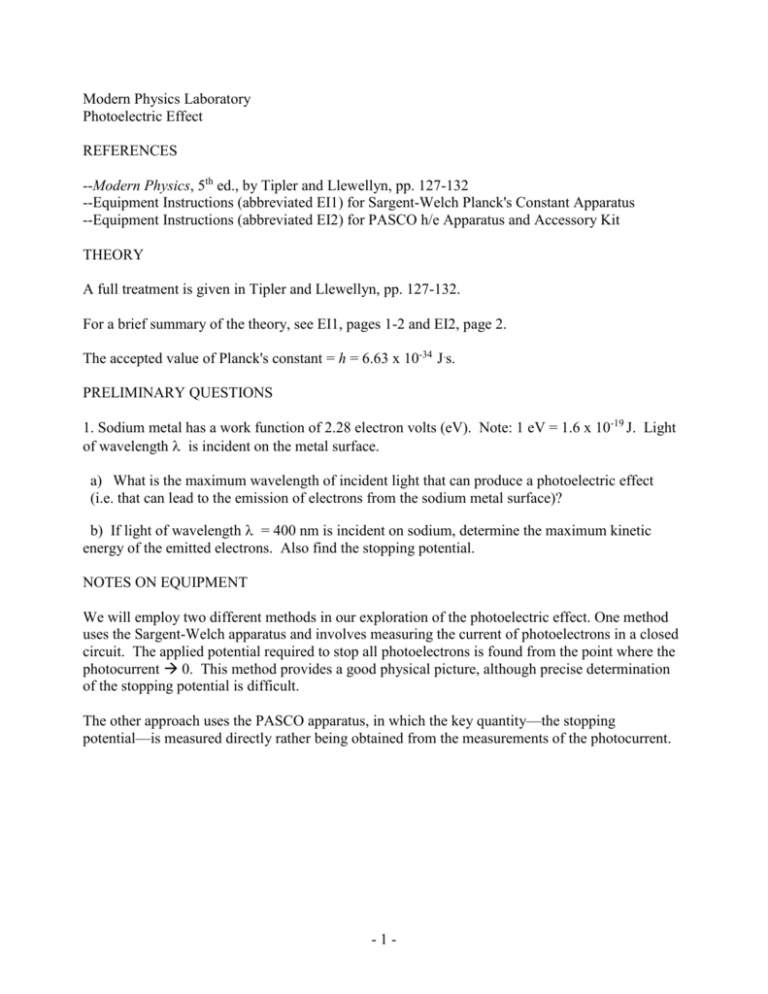
Modern Physics Laboratory Photoelectric Effect REFERENCES --Modern Physics, 5th ed., by Tipler and Llewellyn, pp. 127-132 --Equipment Instructions (abbreviated EI1) for Sargent-Welch Planck's Constant Apparatus --Equipment Instructions (abbreviated EI2) for PASCO h/e Apparatus and Accessory Kit THEORY A full treatment is given in Tipler and Llewellyn, pp. 127-132. For a brief summary of the theory, see EI1, pages 1-2 and EI2, page 2. The accepted value of Planck's constant = h = 6.63 x 10-34 J.s. PRELIMINARY QUESTIONS 1. Sodium metal has a work function of 2.28 electron volts (eV). Note: 1 eV = 1.6 x 10-19 J. Light of wavelength is incident on the metal surface. a) What is the maximum wavelength of incident light that can produce a photoelectric effect (i.e. that can lead to the emission of electrons from the sodium metal surface)? b) If light of wavelength = 400 nm is incident on sodium, determine the maximum kinetic energy of the emitted electrons. Also find the stopping potential. NOTES ON EQUIPMENT We will employ two different methods in our exploration of the photoelectric effect. One method uses the Sargent-Welch apparatus and involves measuring the current of photoelectrons in a closed circuit. The applied potential required to stop all photoelectrons is found from the point where the photocurrent 0. This method provides a good physical picture, although precise determination of the stopping potential is difficult. The other approach uses the PASCO apparatus, in which the key quantity—the stopping potential—is measured directly rather being obtained from the measurements of the photocurrent. -1- PROCEDURE Part A. Measurement of Photocurrent, Determination of Stopping Potential, Effect of Light Intensity on Photocurrent and Stopping Potential Part A uses the Sargent-Welch Planck's Constant apparatus. A1. To measure the photocurrent I we use a very sensitive digital current meter (Keithley picoammeter) in the position labeled "G" in the circuit of Fig. 1 on page 3 of EI1. As a check, we also include an analog microammeter in series with the picoammeter. Connect the circuit in Fig. 1. Have the instructor check the circuit before turning on the power. Also, turn on the mercury vapor light source so that it can warm up. CAUTION: THE MERCURY VAPOR LAMP IS ENCLOSED IN A METAL HOUSING WITH A SMALL APERTURE. DO NOT LOOK DIRECTLY INTO THE APERTURE. A2. To prepare the picoammeter, carry out the following initialization steps. 1) Temporarily disconnect the picoammeter from the circuit. Turn on the picoammeter power. 2) Press the ZCHK button to perform a zero check. The letters "ZC" should appear in the display. 3) To optimize accuracy for measuring very small currents, we also perform a zero correction. Use the range arrow buttons to select the lowest range – the 2 nA range. Then press the ZCOR key. "ZZ" should appear in the display. Press the ZCOR button again and ZC appears. Finally, press the ZCHK button and the display should be cleared. 4) Reconnect the picoammeter in the circuit. A3. The voltage applied to the phototube is read on the voltmeter. The voltage input is a DC power supply. The power supply voltage is adjusted by two knobs on the apparatus, for coarse and fine adjustments. Turn on the power supply and turn both knobs to achieve the maximum tube voltage. This voltmeter reading should be between 3 and 4 volts. If it is not in that range, adjust the power supply voltage to bring the reading into that range. A4. Align the tube with the light from the mercury source. The system should be ready to record data. A5. Insert the 435.8 m(i.e. 435.8 nm) filter in the apparatus. This selects the mercury emission spectral line of that wavelength. Turn the voltage adjustment knobs to the smallest voltage setting. Record the photocurrent as a function of voltage, starting with the smallest voltage and increasing the voltage in steps of 0.1 volt. You should find that the current decreases, passes through zero, and approaches a small negative and approximately constant value. At this point your data is complete. A6. Now insert the beamsplitter between the light source and the tube. The beamsplitter is essentially a thin block of glass mounted at an angle of about 45o relative to the direction of the light from the source. The beamsplitter reduces the incident light intensity without affecting the wavelength. Repeat the measurements of step A5. -2- Part B. Precise Determination of the Stopping Potential as a Function of Incident Light Frequency, Effect of Light Intensity on Stopping Potential Part B uses the PASCO h/e Apparatus. B1. Read and set up the PASCO apparatus as indicated on pages 3-6 of EI2 (through step 12) NOTE: With this apparatus, the photocurrent is not measured. Rather, we measure the stopping potential directly as a function of incident light frequency. We also make detailed observations on the effect of intensity on the stopping potential. The wavelengths and corresponding frequencies used correspond to the spectral lines of the mercury vapor light source, and are separated by passing the light through a diffraction grating (see Fig. 10, page 6 of EI2). The wavelengths and frequencies used are tabulated in Fig. 10. These values are taken as given quantities to be used in your calculations. Read steps 13-15, pages 5-6 of EI2 giving procedures for measuring the stopping potential. Note that you must discharge the system by pressing the PUSH TO ZERO button before each new measurement. CAUTION: THE MERCURY VAPOR LAMP IS ENCLOSED IN A METAL HOUSING WITH A SMALL APERTURE. DO NOT LOOK DIRECTLY INTO THE APERTURE. B2. Perform Experiment 1, Part A on pages 7-8 of EI2. NOTE: In this experiment, omit the observations of the time required to return to the recorded voltage. (The measurements you make with the Sargent-Welch apparatus provide the same information more directly.) B3. Perform Experiment 2 on page 11-12 of EI2. NOTE: In this experiment, use only the five first-order spectral lines of Hg. Omit measurements with the second-order lines. ANALYSIS 1. On the same set of axes, plot a graph of the high light intensity data and of the low light intensity data from Procedure steps A5 & A6, using the 435.8 nm filter. For these graphs, plot the photocurrent I as a function of applied voltage V. For each graph, determine the stopping potential. NOTE: See EI1, pp. 3-4 (especially Fig. 2) for a discussion of the behavior of the data and the way it is reflected in the I vs V graph, as well as a method for obtaining the stopping potential. 2. Based on your data and graphs in Analysis Step 1 above, is there a relation between the light intensity and the photocurrent? If so, describe the relation qualitatively. Is there a relation between the light intensity and the stopping potential? If so, describe the relation qualitatively. -3- 3. Describe qualitatively the predictions of Einstein's photon theory of the photoelectric effect concerning: a) the relative size of the photocurrent for the two light intensities in the data of Procedure Steps A5 and A6. b) the stopping potentials for the two light intensities in the data of Steps A5 and A6. Do your experimental results support Einstein's theory? Explain. 4. In Procedure step B2, the intensity of light of a given wavelength incident on the phototube was varied over a wide range, and the stopping potential was measured. Did the wide variation of the light intensity have a significant effect on the stopping potential, as measured with this apparatus? Discuss in terms of the predictions of Einstein's theory of the photoelectric effect. Was there a small effect on the stopping potential as measured with this apparatus? Can you account for this small effect? HINT: See the NOTE in the box on page 9 of EI2, just above the data table. 5. Determination of Planck's constant. a) Plot the stopping potential Vo as a function of frequency f for the data of Procedure step B3. You should have 5 data points plotted, corresponding to the 5 mercury spectral lines used. Assuming Einstein's equation is applicable, perform a straight-line fit to the data (e.g. using Excel) and determine the slope and y-intercept of the line. From the slope, calculate your experimental value of Planck's constant h. Use SI units in the calculation. Compare your value of h to the accepted value of Planck's constant. What method did you use for this comparison? b) Estimate the uncertainty in the slope and y-intercept by performing the linear fit of the Vo vs f data using the LINEST function in Excel. Include the LINEST output in your report. NOTE: Instructions on using LINEST are given on page 4 of the handout on experimental error. c) From the slope and its uncertainty, calculate an experimental value of Planck's constant h and the uncertainty in h. Express your result as: experimental value uncertainty. Compare your result for h to the accepted value, taking the uncertainty into account. d) From the y-intercept of the Vo versus f graph, determine the work function of the photosensitive in units of electron volts. material (including its uncertainty). Express your result Compare your value of W to data on the work function for metals as given in your textbook. -4-
